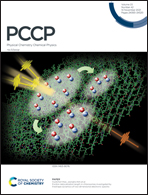The combined action of cations and anions of ionic liquids modulates the formation and stability of G-quadruplex DNA†
Abstract
G-Quadruplex (Gq) formation and stabilization by any molecule is an essential requirement for its application in therapy, especially in oncology. Metal cations have shown higher propensity of the formation of the Gq structure and its stabilization. In this study, the role of both cations and anions of ionic liquids (ILs) on the Gq formation of human telomere (hTeloG) and its stability was investigated using spectroscopic and molecular dynamics simulation techniques. Irrespective of the nature of anions of ILs, tetramethylguanidinium (TMG) cations associated with different anions can form an antiparallel Gq structure in hTeloG. However, the propensity of the formation of an antiparallel Gq structure and its stability depend on the chain length of anions of ILs. Gq is significantly less stable in ILs having longer hydrocarbon chain anions compared to the short chain anions suggesting that the hydrophobicity of the anion plays a critical role in the stability and formation of the Gq structure by ILs. The data indicate that longer hydrocarbon chain anions of ILs preferably interact in the loop region of Gq through hydrophobic interaction which enhances the overall binding of the cation of ILs with Gq causing a decrease in the stacking energy between the G-quartets as well as Hoogsteen hydrogen bonds between the guanine bases leading to the destabilization of the antiparallel Gq structure.



 Please wait while we load your content...
Please wait while we load your content...